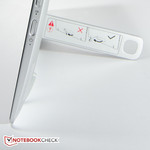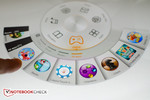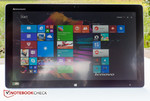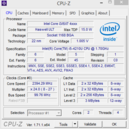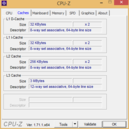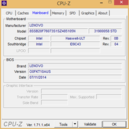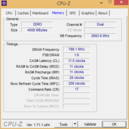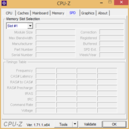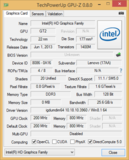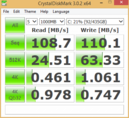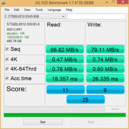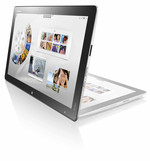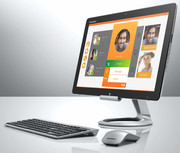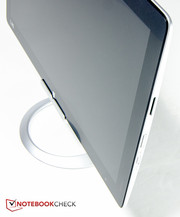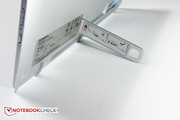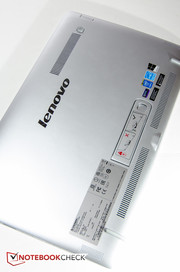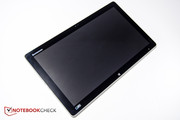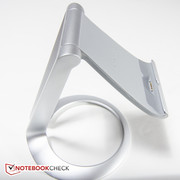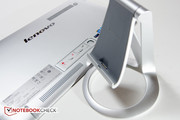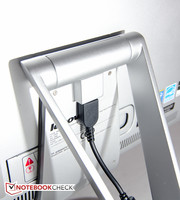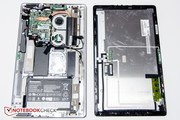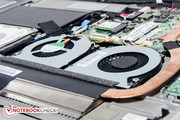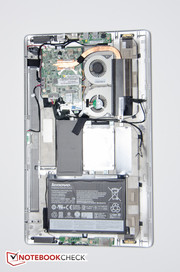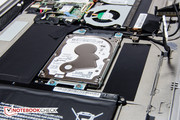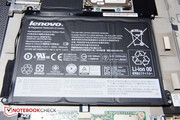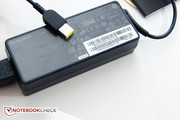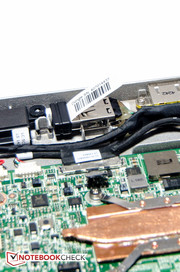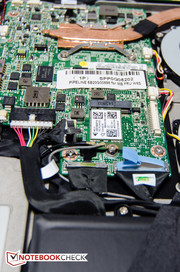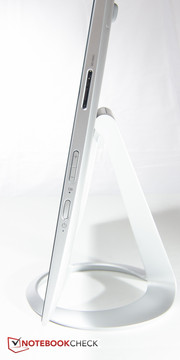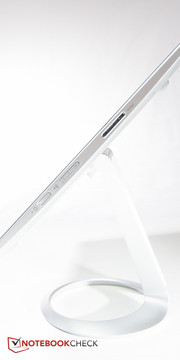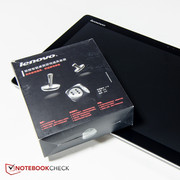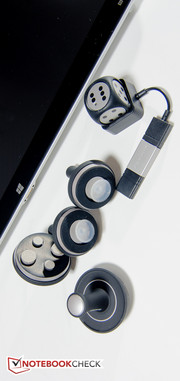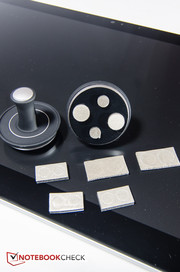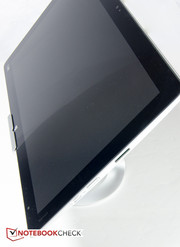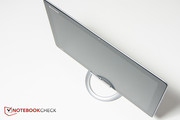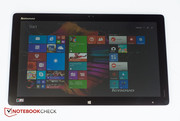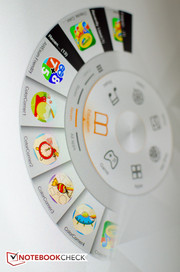Lenovo Horizon 2s-F0AT0003US AIO Review
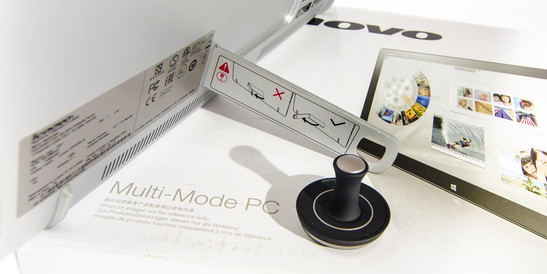
Earlier this month we reviewed Lenovo's 21.5-inch Horizon 2e All-In-One, which, thanks to an integrated battery, also functions as a large multi-user "tabletop" PC. With the optional accessories like joysticks, strikers, and e-dice, friends and family can "enjoy gaming, entertainment, and education on a single device" — at least that's what Lenovo promises.
The Chinese PC maker now extends the family with the 19.5-inch Horizon 2s. At first glance, it seems strange that Lenovo would introduce two AIOs with such similar screen sizes. When we unpacked our review unit, the reason became clear: while the Horizon 2e is downright bulky with its massive integrated kickstand, the 2s is more stylish and substantially slimmer as well as lighter. In many ways the new system reminds us of the Dell XPS 18 AIO.
Our 2s sports a 4th generation Core i5 Haswell processor, 4 GB of RAM, and a 500 MB hybrid hard drive with integrated SSD cache. On paper at least, the system should perform a little snappier than the larger brother. This time around, Lenovo also sent us the optional accessories, so we'll take a closer look at the "tabletop" functionality later in our review.
At the time of writing Lenovo is not selling the 2s yet in their online store, although several retail outfits offer our review model for around $940 - quite a bit more than the larger 2e, which can be found for $700 with i3 processor and 1 TB hard drive.
Case
Though similar in size, the new model looks a lot more upscale than the 2s thanks to much cleaner lines without the considerable "bulge" caused by the adjustable kickstand and the battery located underneath. The back of the Horizon 2s is curved and smooth silver plastic; the front is covered by an edge-to-edge glass display. There's a silver lip that is visible all the way around, but this lip does not extend above the panel. The new model is only about 1.5 cm thick, - which is even thinner than the Dell XPS 18 at 1.8 cm - and weighs about 150 g more than the Dell. The 21.5-inch Horizon 2e is close to 4 cm thick and is also 85 % heavier (4.58 kg vs. 2.48 kg).
Part of the weight loss can certainly be attributed to the kick stand: while the larger model has a solid metal stand which allows the angle to be adjusted in various positions, the smaller model gets a single flip-out support foot in the middle, which positions the 2s quite upright at 105 degrees. Lenovo also offers an optional charging stand for the Horizon 2s, which raises the top edge by 10 cm and allows for angle adjustments from 95 to about 135 degrees. The stand is magnetized and supports the AIO well enough so even occasional knocks aren't a recipe for disaster. Four gray rubber feet protect the Horizon when it's sitting flat on a table in front of the user(s).
The build quality is quite decent despite the plastic back and although the Horizon does twist a bit when torsional forces are applied, the attempts did not result in any creaking sounds. One point of criticism: there is no rubber bumper around the perimeter of the panel, so setting the device down and then trying to flip out the support foot can easily result in slips. Speaking of the support foot: Lenovo elected to use plastic here with no rubber application. We much prefer Dell's design with two rubberized magnesium feet.
Connectivity
The Horizon 2s comes with only two USB 3.0 ports and an SD card reader, which mirrors the configuration of the Dell XPS 18. Just like on the Dell AIO, the ports are located on the edges, which makes them more accessible, but also increases the chances of a mishap during transport if devices like flash drives are plugged in.
Communication
The Horizon 2s supports 802.11ac thanks to a Qualcomm Atheros QC61x4 Wireless Network Adapter 802.11ac. Bluetooth 4.0 and NFC are on board as well.
Accessories
Lenovo bundles the same AccuType wireless keyboard and wireless mouse that are included with the Horizon 2e. Optional accessories once again include a joystick, striker, and e-dice, with the joystick/striker combo (2 sets) selling for $50. The optional aluminum charging stand is quite expensive at around $90, especially since Lenovo doesn't include an additional power adapter.
Warranty
Lenovo offers a 12-month warranty against manufacturer's defects. Since Lenovo doesn't sell the Horizon 2s online yet at the time of writing, we can't report on the costs of extended warranties or additional coverage.
Input Devices
Keyboard & Mouse
As we mentioned above, the keyboard and the mouse are the identical to the the units included with the Horizon 2e. For further information, please take a look at our review here.
Touchscreen
The 10-point multitouch display reacted quickly and reliably without any lag to our inputs. Control is smooth and predictable even in the corners.
Software & Tabletop Mode
Lenovo has preloaded a total of about 60 apps, including multiplayer apps and various educational titles like Air Hockey, Tycoon, Air Supremacy, Paint Touch, Number Touch, Color Corner, Texas Hold’em, Roulette, and Chess, just to name a few. When the Horizon 2e is placed flat on a table, Lenovo's Aura software launches automatically. This happens at an angle below 40 degrees though, so we inadvertently started the software on multiple occasions just by handling the device and tilting it back to far. Alternatively, the software can of course also be launched from the tile interface or from the shortcut on the desktop. Closing out the software requires pressing the "x" for about three seconds.
Initially, the Aura interface consists of a silver-colored wheel in the middle of the screen, which can be simply dragged to any other area if so desired. Different categories - Photo, Video, Music, Education, Games, Apps, and App Shop - are arranged in a circular fashion and expand when tapped. The wheel can also be scrolled with a simple touch of a finger, so the user can position the categories and subsequently the titles so the are easy to read. Plugging in a device like a USB flash drive or hard drive launches a secondary wheel on the Aura desktop, so photos, videos, or music can be imported into Aura if so desired. For details on the AuraU app - used to establish a connection between the Horizon 2s and Android-based devices like smartphones - please refer to our review of the 21.5-inch Horizon 2e.
While the apps like Air Hockey can be played with the fingers, they are much more fun with the striker, two of which are included with the optional gaming accessory kit. The striker has conductive, mesh-covered foam pads on the bottom and is recognized as soon as it is placed on the surface. The joystick allows for increased precision with other touchscreen based games like Air King and attaches to the screen via a little suction cup on the bottom. Our accessory kit also included the e-dice, which consists of a dice with a side length of about 3 cm, a USB charging cradle, and a wireless dongle. One of the dots on the number "six" is a charge indicator. All of the accessories worked quite well, although the joystick seemed to be a little less responsive at times. We suspect that it's going to be mostly families with kids that are going to take advantage of the added functionality the Aura interface provides, as many of the games and titles are clearly designed for a younger audience. That said, the Aura software certainly does much to increase the fun when the AIO is in table-top mode.
Display
The Horizon 2s comes with an IPS display panel from LG Philips. The panel is semi anti-glare and less reflective then the glossy display Dell uses for the XPS 18 AIO, although reflections are still noticeable. The resolution of 1920 x 1080 pixels is identical to the larger brother Horizon 2e as well as the Dell XPS 18 AIO. The panel only supports four resolutions: 1920 x 1080, 1600 x 900, 1280 x 720, and 1024 x 768. The very popular HD resolution of 1366 x 768 is missing, unfortunately.
With an average brightness of around 230 nits, the 2s is dimmer than the XPS at 300 nits, but quite a bit brighter than the Lenovo Horizon 2e, which topped out at a paltry 180 nits average. Full brightness is also available while running on battery.
The brightness distribution of 88 % is not bad, but unfortunately there is noticeable display backlight bleeding especially at the upper edge of the screen. Of course, this is mostly an issue when looking at entirely black backgrounds.
| |||||||||||||||||||||||||
Brightness Distribution: 88 %
Center on Battery: 246.2 cd/m²
Contrast: 490:1 (Black: 0.502 cd/m²)
ΔE ColorChecker Calman: 7.65 | ∀{0.5-29.43 Ø4.78}
ΔE Greyscale Calman: 5.49 | ∀{0.09-98 Ø5}
56.9% AdobeRGB 1998 (Argyll 1.6.3 3D)
64.2% AdobeRGB 1998 (Argyll 3D)
87.3% sRGB (Argyll 3D)
64.3% Display P3 (Argyll 3D)
Gamma: 1.69
CCT: 6409 K
Both the black value and the contrast ratio are fairly mediocre at only 0.502 cd/m² and 490:1 respectively. The brighter Dell XPS 18 is capable of darker blacks (0.34 cd/m², 932:1) and the larger brother outperforms both (0.18 cd/m² and 1120:1). When watching movies, the bars on top and the bottom of a wide-screen movie were noticeably less dark than the display bezel.
The display covers the professional color spaces AdobeRGB and sRGB at about 57 % and 77 % and surpasses the display of the Horizon 2e by a few percentage points, although it trails the Dell by roughly by the same margin. There are certainly better choices for photo editing and graphics work, but the Horizon 2s should still suffice for most home users as far as color space coverage is concerned.
As shipped, the color and grayscale accuracy are not particularly high considering this is an IPS display. Our analysis with an X-Rite spectrophotometer revealed average DeltaE deviations of about 7.7 for color and 5.5 for grayscale. A calibration improves color accuracy quite a bit with the average DeltaE now at about 2.7, although even without calibration most users won't be able to identify a particular color cast. Overall, the color accuracy of this display is certainly adequate for home users.
Although the contrast is lacking a bit, the Horizon 2s performs reasonably well outdoors thanks to the decent brightness and the display's anti-glare coating. The display content is visible even when the sun is out, although direct sunlight should be avoided. Bright light sources still cause reflections, which are hard to avoid since the angle of the Horizon 2s without the optional stand can't be adjusted. Of course, in most cases, the system will remain stationary, so the outdoor performance is not that much of an issue.
As typical for IPS displays, the viewing angle stability is very good with the picture stable even at quite shallow angles without any significant loss of contrast or color inversions. Since one of the main purposes for this system is the operation in table-mode, this is particularly important, as up to four users might look at the display from four different locations.
Performance
The Horizon 2s comes with a mainstream Core i5-4210 ULV processor, 4 GB of RAM, and a 500 GB hybrid hard drive with 8 GB of SSD cache. This model is the only version available in retail stores thus far; as we mentioned earlier, the Horizon 2s is not available directly from Lenovo. At this point we are not sure if Lenovo will release other models or not.
We should note here that the RAM is not user replaceable or upgradable, which makes extending the life of the system a few years down the line not possible. The Horizon 2s does not offer a dedicated graphics card as an option, so the system relies on the integrated Intel HD 4400.
Processor
Our Horizon 2s review model is equipped with the mid-level Core i5-4210U CPU. This ULV processor with a TDP of 15 watts is a very frequent choice for Ultrabooks, thin-and-lights, and other applications where low power consumption is more important than outright performance. While the CPU is rated at 1.7 GHz, Turbo Boost can overclock the cores to 2.7 GHz for a single core and 2.4 GHz for both cores. The Cinebench R11.5 benchmark scores of 1.19 points for the single and 2.59 points for the multi test are exactly were we would expect them to be with only very minor differences compared to other systems. When we repeated the test with the Horizon 2s running on battery, the result was identical. This means that full performance is available at all times.
While the i5-4210U can handle the normally encountered tasks like browsing or word processing, power-hungry applications will push the CPU to its limited rather quickly.
| Cinebench R11.5 | |
| CPU Single 64Bit (sort by value) | |
| Lenovo Horizon 2s-F0AT0003US | |
| Dell XPS 18 | |
| Lenovo Horizon 2e-F0AS0014US | |
| CPU Multi 64Bit (sort by value) | |
| Lenovo Horizon 2s-F0AT0003US | |
| Dell XPS 18 | |
| Lenovo Horizon 2e-F0AS0014US | |
System Performance
As always, we use the various PCMark benchmark tests to get an idea of the overall system performance. The Lenovo AIO scored 4017 points for the PCMark 7 benchmark test, which is a respectable result, as it outperforms systems like the Lenovo Flex 2 15 (3725 points), which is equipped with the same CPU and also sports a hybrid hard drive. The Dell XPS 18 (4231 points) still outperformed the 2s despite its 3rd-generation processor and integrated HD 4000 GPU. The reason: a substantially higher storage score.
Subjectively, the Horizon 2s feels quite a bit more lively than the larger 21.5-inch Horizon 2e. Especially the launch of the Aura software happened a bit more sluggish on the latter, while our review system didn't have any issues here.
| PCMark 7 Score | 4017 points | |
| PCMark 8 Home Score Accelerated v2 | 2948 points | |
| PCMark 8 Creative Score Accelerated v2 | 3372 points | |
| PCMark 8 Work Score Accelerated v2 | 3846 points | |
Help | ||
Stress Test
We run Prime95 and FurMark while checking with different tools to identify potential throttling issues. With just Prime95 running, the CPU cores originally started out at their maximum Turbo speed of 2.4 GHz with one or the other core occasionally accelerating to 2.7 GHz. At this point, the temperature of the CPU hovered around 53 degrees C. Within 20 seconds, the CPU temperature shot up to 99 degrees C, but the cores immediately dropped to 2.1 GHz and the temperature recovered and held steady around 62-64 degrees C. After 20 minutes, the cores registered 65 degrees C and fluctuated between 2.2 and 2.4 GHz. With FurMark running on its own, the GPU initially dropped to 700 / 800 MHz (core / memory) at around 58 degrees C, but stabilized at 62 degrees C after approximately 20 minutes at 800 / 800 Mhz and remained there for the duration of the test. With both Prime95 and FurMark active, the CPU only reached about 58 degrees C with the cores fluctuating between 900 and 1000 MHz. The GPU maintained 700 / 800 MHz at 62 degrees. After 3 hours, the the picture hadn't changed much, although the GPU core speed would now occasionally dip down to 650 Mhz before rebounding to 700 MHz.
Since the Core i5-4210U is an ULV CPU, the behavior above is not entirely unexpected, although the throttling of the CPU cores is a bit higher than what we would've hoped for. Still, we should point out that the average user will likely not encounter the performance-throttling scenario listed above during normal use.
A quick check with 3DMark 11 following the stress test showed no change in performance whatsoever; an additional benchmark test on battery power also ended with a nearly identical score.
Storage Devices
The Seagate ST500LX012-SSHD-8GB is a hybrid hard drive with an integrated 8 GB SSD drive. The performance of the drive with an average transfer rate of almost 89 MB/s is actually higher than what we normally see from 5400 RPM hard drives, but still not even close to the performance of entry-level SSDs. Running the same application or benchmark several times in a row did improve the performance slightly thanks to the caching algorithms. We should note here that the this particular Seagate hard drive model is only 5 mm thick, which might be important for potential upgrade considerations. We did not check to see if a larger drive (7 mm) fits without interfering the back panel.
GPU Performance
The integrated Intel HD 4400 runs at a nominal 600 and 800 MHz for the core and the memory, but the Turbo can overclock the core to 1000 MHz when an increase in performance is needed. The 3DMark 11 score of 1009 is actually quite high and beats out systems with the same processor and GPU: the Toshiba Satellite Radius P50W-BST2N01, for example, only scored 858 points (- 15 %). The Dell XPS 18 AIO with previous-generation Intel Core i5-3337U and Intel HD 4000 fell even further behind with 632 points (- 37 %).
3DMark 06 paints a similar picture with the Horizon 2s outperforming the Toshiba convertible quite significantly (5786 vs. 4924 points). According to Hwinfo, the RAM of the 2s runs in dual-channel mode, which might explain the difference in performance.
| 3DMark 06 Standard Score | 5786 points | |
| 3DMark Vantage P Result | 3909 points | |
| 3DMark 11 Performance | 1009 points | |
| 3DMark Ice Storm Standard Score | 46294 points | |
| 3DMark Cloud Gate Standard Score | 4492 points | |
| 3DMark Fire Strike Score | 599 points | |
Help | ||
Gaming Performance
As expected, the gaming performance is far from great. Given the price point of close to $1000, we would like at least the option of an entry-level dedicated graphics card to make game play more enjoyable for the user. As is, the Horizon 2s might handle some entry-level and older games, but higher resolutions ans high settings are simply not in the cards.
Emissions
System Noise
This is one of the areas where the AOI falls short: even during most idle tasks, the 2s can exceed 36 dB and is therefore quite audible even from several feet away. The Horizon 2e reached 33 dB during idle, the Dell XPS 18 only 31 dB.
Under load, the system reaches 44 dB and is now loud enough to be heard across a room. It doesn't help that the dual fan system is fairly obtrusive-sounding, so even shorter sessions can get annoying quickly. The Dell XPS 18, which is also a very slim system, topped out around 40 dB, which is still loud, but more tolerable.
Noise level
| Idle |
| 34.8 / 35 / 36.4 dB(A) |
| Load |
| 37.8 / 44.1 dB(A) |
 | ||
30 dB silent 40 dB(A) audible 50 dB(A) loud |
||
min: | ||
Temperature
Despite the very active fan system, the Horizon 2s can reach up to 36 degrees C during idle. Under full load, on the other hand, we measured a maximum of about 44 degrees C, which is less than both the Horizon 2e and the Dell XPS 18 at 47 and 49 degrees C, respectively. The hottest areas are on the back near the ventilation grilles on top edge of the device. Placing the Horizon 2s on the lap is still possible without any great discomfort.
(+) The maximum temperature on the upper side is 39.4 °C / 103 F, compared to the average of 35.4 °C / 96 F, ranging from 19.6 to 60 °C for the class Convertible.
(±) The bottom heats up to a maximum of 44.2 °C / 112 F, compared to the average of 36.8 °C / 98 F
(±) In idle usage, the average temperature for the upper side is 32.4 °C / 90 F, compared to the device average of 30.3 °C / 87 F.
(+) The palmrests and touchpad are reaching skin temperature as a maximum (33 °C / 91.4 F) and are therefore not hot.
(-) The average temperature of the palmrest area of similar devices was 27.9 °C / 82.2 F (-5.1 °C / -9.2 F).
Speakers
The stereo speakers are located on the back on the outside lower edges. The sound is rather tinny, mids are undefined, and the bass is close to non-existent. Although the maximum volume level is not very loud, the sound doesn't suffer from noticeable distortions. Just like with the Horizon 2e, the sound doesn't change much when the Horizon is used in table-top mode on a hard surface. For playing games, the sound quality is sufficient, but for all other purposes, external 3.5 mm solutions are recommended.
Battery Life
Because of the smallish 49 Wh battery - the Dell XPS 18 comes with 69 Wh battery - the battery life of the Horizon 2s is pretty mediocre. With the screen brightness turned all the way down and the Power Saver Profile enabled, the S2 shut down after only 4 hours and 40 minutes during the Battery Eater Reader's test. When we ran the Classic test (maximum brightness, Performance Profile), the 2s only lasted about 1 hour and 15 minutes. For the WLAN test, we set the brightness to about 150 nits to simulate realistic, day-to-day conditions. The 2-in-1 shut down after 2 hours and 30 minutes of automated web browsing, which is way shorter than the XPS 18 at 4 hours and 50 minutes. The Lenovo 2e, which has almost the same size battery, lasted 1 hour and 50 minutes. It's quite unfortunate, really: the smaller dimensions and slim weight make the Lenovo Horizon 2e more portable, but table-top gaming sessions on the coffee table won't last very long if the power adapter isn't brought along.
Verdict
The Horizon 2s is Lenovo's newest 2-in-1 system and as such it certainly delivers. We like the innovative Aura interface, which makes the table-top mode fun for everyone thanks to the preinstalled games and educational titles for the smallest family members. The accessories Lenovo designed for that purpose work as intended and improve the experience. Used as a desktop, the system offers a bright and colorful screen and adequate performance for day-to-day tasks. The keyboard works well enough, although we experienced the same issues with the mouse that we had encountered with the bigger brother, as the mouse cursor got quite jumpy even just two feet away from the system. We just wish that the battery life was a little longer: the 2e is more likely to be moved from room to room to watch movies or play games, but without the power adapter, the fun is short-lived.
At a price of around $1000, the system is no bargain. Lenovo's own Horizon 2e starts closer to $700, but is significantly more bulky and cumbersome to transport. Dell's XPS 18 with last-generation Intel Core i3 Processor starts at $750, although there is also a high-performance version with Core i7 CPU and 256 GB SSD which starts at $1400 including the stand.




